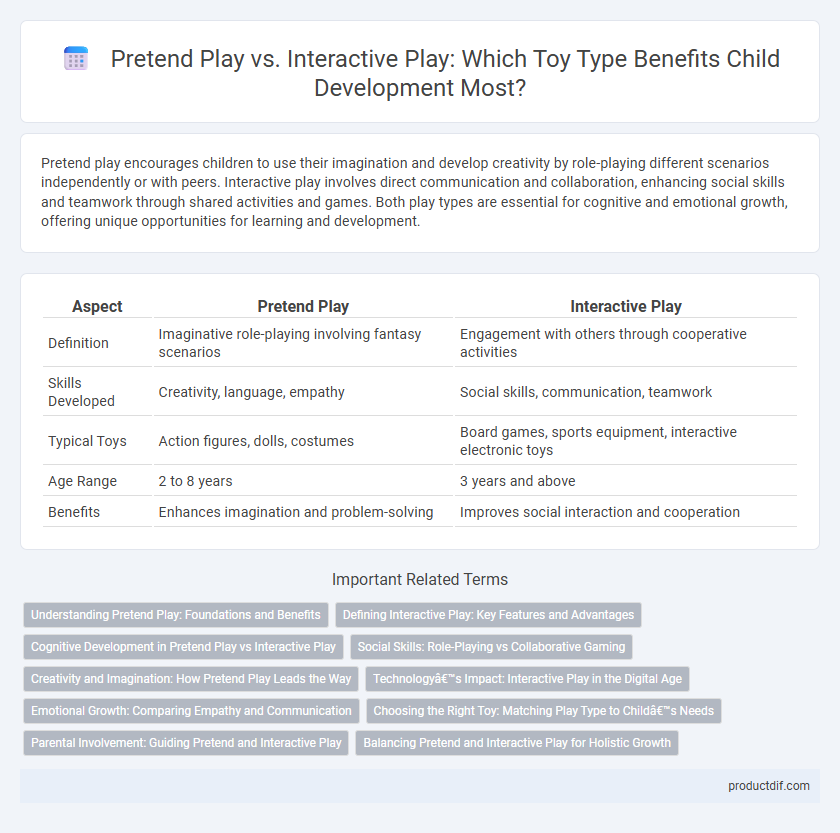Pretend play encourages children to use their imagination and develop creativity by role-playing different scenarios independently or with peers. Interactive play involves direct communication and collaboration, enhancing social skills and teamwork through shared activities and games. Both play types are essential for cognitive and emotional growth, offering unique opportunities for learning and development.
Table of Comparison
| Aspect | Pretend Play | Interactive Play |
|---|---|---|
| Definition | Imaginative role-playing involving fantasy scenarios | Engagement with others through cooperative activities |
| Skills Developed | Creativity, language, empathy | Social skills, communication, teamwork |
| Typical Toys | Action figures, dolls, costumes | Board games, sports equipment, interactive electronic toys |
| Age Range | 2 to 8 years | 3 years and above |
| Benefits | Enhances imagination and problem-solving | Improves social interaction and cooperation |
Understanding Pretend Play: Foundations and Benefits
Pretend play, also known as imaginative play, is a crucial developmental activity where children create scenarios and roles using toys and objects, promoting cognitive flexibility and social skills. This type of play lays the foundation for problem-solving, emotional regulation, and language development by allowing children to explore different perspectives and practice communication. Unlike interactive play, which emphasizes direct engagement with others, pretend play fosters autonomous creativity and inner narrative building essential for lifelong learning.
Defining Interactive Play: Key Features and Advantages
Interactive play involves active engagement between participants, often facilitated by toys that encourage communication, collaboration, and problem-solving skills. Key features of interactive play include shared attention, turn-taking, and responsiveness, which foster social development and enhance cognitive abilities in children. Advantages of interactive play are improved language skills, emotional understanding, and teamwork, making it essential for holistic childhood development.
Cognitive Development in Pretend Play vs Interactive Play
Pretend play enhances cognitive development by fostering imagination, problem-solving skills, and symbolic thinking, allowing children to experiment with scenarios and roles independently. Interactive play stimulates social cognition, communication, and collaborative problem-solving through direct engagement with peers or adults. Both forms of play contribute uniquely to cognitive growth, with pretend play emphasizing internal thought processes and interactive play promoting external social interactions.
Social Skills: Role-Playing vs Collaborative Gaming
Role-playing in pretend play enhances social skills by encouraging children to adopt different perspectives and practice empathy through character-driven scenarios. Collaborative gaming in interactive play fosters teamwork, communication, and problem-solving as players work together to achieve common goals. Both play types contribute uniquely to social development by promoting imaginative engagement and cooperative interaction, essential for effective interpersonal relationships.
Creativity and Imagination: How Pretend Play Leads the Way
Pretend play stimulates creativity and imagination by allowing children to invent scenarios and explore roles freely, fostering cognitive flexibility and problem-solving skills. Unlike interactive play, which often follows structured rules and social interactions, pretend play encourages open-ended storytelling and symbolic thinking. This unstructured creativity enhances brain development and nurtures innovative thinking, making pretend play a vital tool in early childhood growth.
Technology’s Impact: Interactive Play in the Digital Age
Interactive play in the digital age revolutionizes traditional pretend play by integrating advanced technologies such as augmented reality (AR) and artificial intelligence (AI), enhancing engagement and creativity. Digital platforms offer immersive experiences where children can collaborate and problem-solve in real-time, fostering social interaction and cognitive development. This technological evolution expands the scope of interactive play beyond physical toys, creating dynamic environments that blend imagination with digital innovation.
Emotional Growth: Comparing Empathy and Communication
Pretend play fosters emotional growth by encouraging children to develop empathy through role-playing and understanding different perspectives. Interactive play enhances communication skills by promoting verbal and non-verbal exchanges between peers, leading to improved social interaction. Both play types are crucial for building emotional intelligence, with pretend play deepening empathy and interactive play strengthening communication abilities.
Choosing the Right Toy: Matching Play Type to Child’s Needs
Choosing the right toy for pretend play involves selecting items that stimulate imagination and role-playing, such as costumes, dolls, or kitchen sets, fostering creativity and social skills. Interactive play toys, including puzzles, building blocks, and electronic learning devices, are designed to enhance cognitive development, problem-solving abilities, and hand-eye coordination. Matching the toy to the child's developmental stage and interests ensures engagement and supports targeted growth in emotional, social, and intellectual domains.
Parental Involvement: Guiding Pretend and Interactive Play
Parental involvement in pretend play enhances children's creativity and social skills by providing imaginative scenarios and role-playing cues. During interactive play, parents facilitate communication and cooperation, promoting problem-solving and emotional development. Guiding both types of play ensures balanced cognitive growth and strengthens parent-child bonding through active engagement.
Balancing Pretend and Interactive Play for Holistic Growth
Balancing pretend play and interactive play is essential for holistic child development, fostering creativity, social skills, and cognitive abilities simultaneously. Pretend play encourages imagination and problem-solving, while interactive play promotes communication, cooperation, and emotional intelligence. Integrating both play types leads to improved language development, empathy, and critical thinking in children.
Pretend play vs interactive play Infographic

 productdif.com
productdif.com